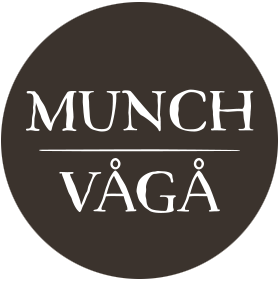Childhood and upbringing
Edvard Munch’s childhood was characterised by a lot of illness, and he had to stay indoors for long periods in the winter. The home and studies of the family were important in his early development as an artist. His parents, Laura and Christian, were Christian, as were much of the extended family. His paternal grandfather, Edvard Storm Munch, was a provost in Kristiania, and his great-grandfather Peder Sørensen Munch was a pastor in Vågå. Past generations were a frequent topic of conversation in the family home, and a portrait of Edvard Munch’s great-grandmother Christine Storm Munch hung above his bed, and his sister Inger Marie often visited Vågå at the Ullinsvin parsonage.
There were five siblings: Johanne Sophie (1862), Edvard (1863), Peter Andreas (1865), Laura Cathrine (1867) and Inger Marie (1868). Their father worked as a military doctor, and was known for being friendly and sociable. The family moved around Kristiania a lot, and had the material necessities of life.
The mother, Laura, was frequently ill and died of tuberculosis on 29 December 1868. Afterwards, Laura’s younger sister Karen Bjølstad moved into the flat to manage the household and look after the children. Edvard Munch became her favourite, and later in life he tried to return some of the care he received by writing letters and providing money. The father went through something like a personality change after his wife died, and his rages would frighten the children. At times he was a present and warm dad who told fairy tales and anecdotes. At other times, he was strict, distant and irascible. He was caring, but at times this was expressed through constant anxiety over Edvard and the other children’s health. In 1877, Edvard Munch’s older sister Johanne Sophie died of tuberculosis, so Edvard experienced death at close hand several times during childhood and adolescence. His father and his brother Andreas also died when Edvard was a young man, while his sister Laura struggled with significant psychiatric problems throughout her life. It was therefore his youngest sister, Inger Marie, and his aunt Karen that Edvard Munch remained close to his entire life.
Life as a painter
From the time he was 13 or 14, Edvard Munch started visiting art galleries by himself, and at 17 he decided to become a painter. When young, he hung around with the Kristiania bohemians, which went against everything his father stood for. Edvard Munch travelled to Copenhagen, Berlin, Paris, Rome and other big cities to create the art he wanted to create. He led a wandering life that cannot be characterised as particularly healthy, but he had an admirable work ethic and created great art during his years abroad. In his lifetime, he was both admired and despised, and constantly received a lot of attention. In 1909, he returned to Norway and turned most things in his life upside-down. He isolated himself, rarely visited cafés or met friends, but continued to work just as hard as previously. From 1916 he lived at Ekely, and in his last years Edvard Munch lived in isolation on his property and left nearly all his artistic production, texts and property to Oslo municipality.







